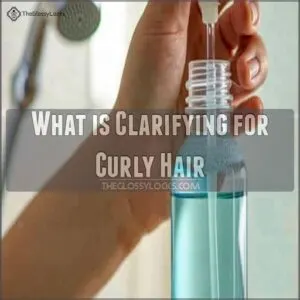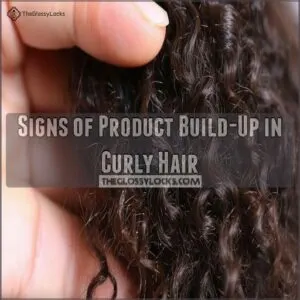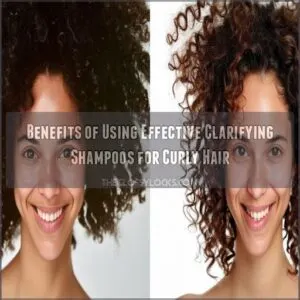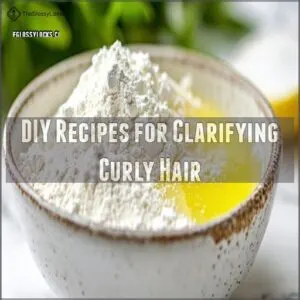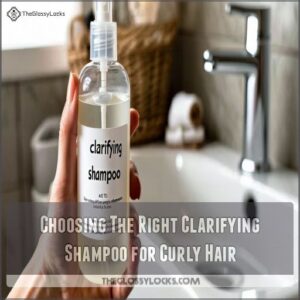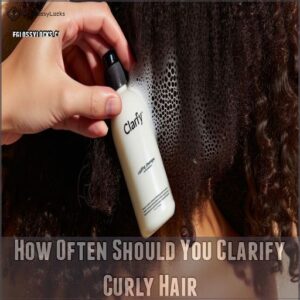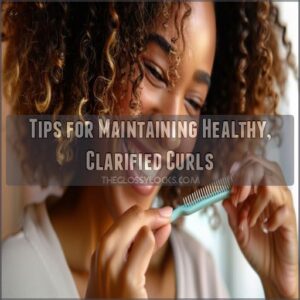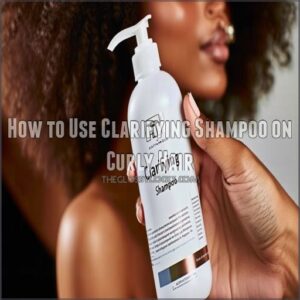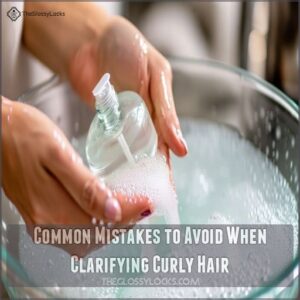This site is supported by our readers. We may earn a commission, at no cost to you, if you purchase through links.
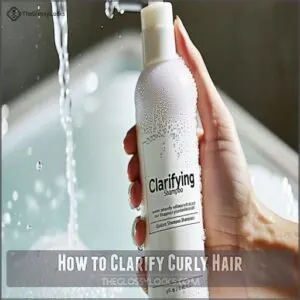 Clarifying curly hair can feel like giving your curls a fresh start.
Clarifying curly hair can feel like giving your curls a fresh start.
Begin by applying an oil about 30 minutes before washing, like prepping your car for a road trip.
After detangling, soak your hair with warm water.
Use a clarifying shampoo on your roots, massaging everything—even your hairline.
For an extra kick, mix baking soda with your shampoo or try an apple cider vinegar rinse, which offers a shine boost.
Home remedies like clay or lemon juice are great too.
But remember, balance is key.
Curious about more DIY options for your curls’ new lease on life?
Keep reading!
Table Of Contents
- Key Takeaways
- What is Clarifying for Curly Hair
- How to Clarify Curly Hair
- Signs of Product Build-Up in Curly Hair
- Benefits of Using Effective Clarifying Shampoos for Curly Hair
- DIY Recipes for Clarifying Curly Hair
- Choosing The Right Clarifying Shampoo for Curly Hair
- How Often Should You Clarify Curly Hair
- Tips for Maintaining Healthy, Clarified Curls
- How to Use Clarifying Shampoo on Curly Hair
- Common Mistakes to Avoid When Clarifying Curly Hair
- Frequently Asked Questions (FAQs)
- How do you treat curly hair?
- What are some good ways to deep condition hair?
- Should I use clarifying shampoo If I’m a curly girl?
- Should you clarify your hair?
- Is clarifying shampoo safe for curly hair?
- Does a clarifying shampoo dry out your curls?
- Does curly hair need to be clarified?
- How do I know if my curly hair needs clarifying?
- How do you remove product buildup from curly hair?
- How often should curly hair be clarified?
- Can clarifying shampoos damage curly hair?
- What natural oils are safe after clarifying?
- How does water hardness affect curl clarification?
- Are there specific clarifying products for color-treated curls?
- Can clarifying help reduce dandruff in curly hair?
- Conclusion
Key Takeaways
- You’ll need to clarify your curls every 4-6 weeks to remove product buildup, with more frequent treatments if you use heavy styling products or live in a hard water area.
- You can make effective DIY clarifying solutions at home using ingredients like apple cider vinegar, bentonite clay, or sea salt scrubs mixed with natural oils.
- Don’t over-clarify your hair – look for signs like dullness, a heavy feeling, or white residue to know when it’s time for a treatment.
- After clarifying, always follow up with a deep conditioner to restore moisture and keep your curls bouncy and defined.
What is Clarifying for Curly Hair
Clarifying curly hair means giving your curls a fresh start by removing all the product buildup, excess oils, and impurities that weigh them down.
It’s like a reset button for your hair, bringing back your curls’ natural bounce and shine.
Causes of Product Build-Up
Little things like hard water, styling products, and persistent use of dry shampoos can cause product buildup, leaving your curls as stiff as a board. Hard water, in particular, can lead to calcium build up in hair, making it challenging to achieve healthy, bouncy curls.
You might notice:
- Silicone buildup: Makes hair heavy and dull.
- Mineral oil residue: Blocks moisture.
- White flakes: Resembles dandruff but isn’t.
These culprits sneak in, stunting your curl routine!
Benefits of Clarifying for Curly Hair
Dealing with build-up can feel overwhelming, but clarifying curly hair brings perks you can’t ignore.
You’ll notice reduced frizz, more defined curls, and an enhanced shine that turns heads.
Plus, your hair absorbs moisture better, leaving a healthy scalp behind.
It’s like hitting the refresh button for your curls—setting them free from the weight of yesterday’s products.
Common Ingredients That Cause Buildup
Let’s talk about hidden curl enemies—silicones, mineral oils, and petroleum.
They’re sneaky ingredients in many styling products, leaving your hair heavy and dull.
Even dry shampoo can contribute to this buildup.
Using a gentle sulfate free shampoo can help minimize this issue.
When you wash your hair, they cling on, making it more like a heavy coat than a free-flowing mane.
Time to shed the grime and reclaim those curls!
How to Clarify Curly Hair
So, you get it—clarifying shampoos are your curly hair’s best friend. Now, how do you actually use one? It’s easier than you think! First, wet your hair thoroughly. Next, apply the clarifying shampoo, focusing on your scalp. Gently massage it in, working your way down to the ends. Then, rinse thoroughly. Finally, follow up with a deep conditioner to replenish moisture. That’s it! You’ll feel the difference instantly.
Think of it like this:
- It’s like giving your curls a power wash.
- You’re removing that gunk that weighs them down.
- Your curls will bounce and shine.
- You’ll rediscover your hair’s natural beauty.
Remember, clarifying shampoo frequency depends on your hair type and product usage. Experiment to find what works for you. Don’t worry about overdoing it; your curls will thank you for the extra TLC. And if you’re feeling adventurous, you can always try a DIY clarifying solution. It’s surprisingly easy and fun!
Signs of Product Build-Up in Curly Hair
Ever feel like your curls are more blah than bouncy?
If your hair looks dull despite your best efforts, it might be crying out for a clarifying shampoo to tackle pesky product build-up.
Dull, Lifeless Hair
Ever looked at your curls and thought they resembled yesterday’s spaghetti—dull and lifeless?
This can be a classic sign of product buildup.
Hair health takes a hit when residue sits like an unwanted guest on your scalp, which is why a scalp detox treatment can be beneficial in removing product buildup.
Embrace clarifying to restore vibrancy, enhance your curl pattern, and regain control, helping your locks shine with the radiance you love.
Heavy Hair
Feeling like your hair weighs a ton? Heavy hair often signals product build-up, a common challenge for curly hair. Here’s how you can keep your curls light and bouncy:
- Use lighter products – Avoid heavy hair products.
- Clarify monthly – Reset your strands.
- Embrace natural drying – Skip the blow-dryer.
- Rinse thoroughly – Make sure no residue lingers.
Dry Hair After Moisturizing
Noticed your curls feeling dry even after slathering on moisturizer? That’s a surefire sign of product buildup.
Think of it like putting on a raincoat over a wet shirt—it just won’t stay dry underneath!
Your hair mightn’t be absorbing moisture because the buildup acts like a shield.
A good clarifying session can break through the gunk and revive your curls.
White Residue on Scalp/Hair
Spotting white residue on your scalp or hair after moisturizing is like finding breadcrumbs to the mystery of buildup.
Identifying the culprit often leads you to styling products or even hard water.
DIY solutions like apple cider vinegar rinses can help.
Residue removal tips and adjusting routine products keep your curls fresh and your scalp health in check.
Coated Feeling
Finding your curls slick instead of bouncy might mean a coated feeling is in the works.
Picture your strands wrapped in a stubborn film of product residue.
This buildup doesn’t just weigh your hair down; it messes with hair texture too.
A clarifying routine is your best friend here, helping with buildup removal and restoring your curls’ natural vibe.
Benefits of Using Effective Clarifying Shampoos for Curly Hair
To achieve gorgeous curls, using the right styling product, such as hair gel or mousse, is crucial for controlling frizz and adding definition. You’ll rediscover your curls’ natural bounce and shine by removing product buildup with a clarifying shampoo.
This deep clean helps your favorite styling products work better, leaving your hair healthier and more manageable.
Are Clarifying Shampoos Safe to Use?
Using clarifying shampoos is generally safe, offering benefits like removing product residue without harming your scalp.
They’re fine for color-treated hair but should be used sparingly to maintain color vibrancy.
Here are three perks:
- Revive those curls with bounce.
- Promote scalp health by eliminating buildup.
- Support hair growth by keeping follicles clear.
Use wisely for best results!
Reasons Why You Should Stay Away From Clarifying Shampoos
Clarifying shampoos can be too harsh for some hair types and scalps, especially those with sensitivity.
Overuse can lead to hair breakage and weak roots, often causing dry and brittle hair. Overuse strips natural oils, leaving hair dry and brittle.
Pay attention to frequency and ingredients, as they should match your hair’s purpose.
Keep those curls luscious by knowing when and how to pamper them, balancing cleansing with nourishment.
Choose carefully!
DIY Recipes for Clarifying Curly Hair
When your curls seem more weighed down than bouncy, it’s time to try some easy DIY clarifying recipes at home.
Clarifying recipes can restore your curls’ natural charm without breaking the bank.
With simple ingredients like baking soda, lemon juice, and even a pinch of sea salt, you can restore your curls’ natural charm without breaking the bank.
Classic Clarifying Solution
Ever wonder how to get those curls back to their natural glory?
A classic DIY clarifying solution might be just what you need.
Mix some Castile soap with baking soda and a bit of tea tree oil.
This magical concoction:
- Cleanses deep down
- Brings back shine
- Refreshes your curls
- Controls build-up
Try it and see the bounce return!
Simple Clarifying Solution
Ready for a natural DIY clarifying trick? Mix lemon juice, olive oil, and a pinch of salt!
The lemon brightens your curls and kicks out buildup, while olive oil swoops in to moisturize those thirsty locks.
When looking for a gentle, store-bought alternative, consider using sulfate-free curly shampoos that cleanse hair without stripping natural oils.
A pinch of salt adds that extra exfoliating kick.
In no time, you’ll reveal shinier, bouncy curls that scream freedom!
Sea Salt Scrub Solution
Try a DIY sea salt scrub solution if you want to refresh your curls with a simple, homemade touch.
Mix liquid Castile soap, aloe vera gel, and coarse sea salt for a textured scrub that exfoliates your scalp and lifts away product buildup.
Think of it as a beach day for your hair, adding volume and life back into your curls!
Bentonite or Rhassoul Clay + ACV Rinse
This deep-cleaning treatment is surprisingly simple! Mix bentonite or rhassoul clay (your choice of clay type!) with apple cider vinegar (ACV) and water. You can find a variety of products for an ACV hair rinse online, such as at ACV hair rinse products.
- Apply the mixture to your scalp and hair.
- Let it sit for 10-15 minutes.
- Rinse thoroughly.
- Follow with conditioner.
ACV benefits include balancing pH and shine.
Experiment with recipe variations—the possibilities are endless! Rinse frequency depends on your hair’s needs. Remember, less is more when applying clay.
Choosing The Right Clarifying Shampoo for Curly Hair
Choosing the right clarifying shampoo can feel like finding a needle in a haystack, but don’t worry, it’s simpler than it seems.
Focus on shampoos with gentle surfactants and hydrating agents while steering clear of harsh sulfates to keep your curls bouncy and happy.
Ingredients to Look for in a Clarifying Shampoo
Look for clarifying shampoos packed with build-up removers like sodium polystyrene sulfonate and acetic acid.
Opt for sulfate-free options to be kinder to your curls.
Gentle surfactants such as decyl glucoside provide a soft cleanse, while hydrating agents like glycerin keep dryness at bay.
Cationic polymers help detangle and enhance your hair’s natural shine and bounce. To maintain defined curls and prevent product buildup, incorporating a clarifying wash routine can be beneficial.
Ingredients to Avoid in a Clarifying Shampoo
While you’re scanning shampoo labels like a detective, steer clear of harsh sulfates like sodium lauryl sulfate, silicones that make curls slippery, and sneaky parabens.
They may weigh down your curls, making them feel lifeless.
Mineral oils and petroleum can also block moisture.
Keep curls bouncy by avoiding these culprits, letting your hair breathe free and easy.
How Often Should You Clarify Curly Hair
Deciding how often to clarify your curly hair, which requires extra moisture due to its tendency to be drier and more prone to frizz control methods, depends on various factors like product use and lifestyle, so it might feel like solving a mystery without clues.
Start once a month, and adjust as you learn what makes your curls bounce with joy or droop in distress.
Factors That Affect Clarifying Frequency
Finding the right clarifying frequency for your curly hair isn’t a one-size-fits-all answer.
It depends on your hair type, how many products you use, your lifestyle, and even the shampoo routine you follow.
Hard water can also play a role, making it important to adjust based on your environment and individual needs to keep those curls looking fabulous.
How to Determine Your Clarifying Frequency
Life’s busy schedule and product choices can muddy the waters of your hair care routine.
To pinpoint your ideal clarifying frequency, consider these factors:
- Hair type: For those with 3C hair, which is characterized by tightly coiled strands, thicker curls might need less frequent clarifying.
- Lifestyle factors: swim in chlorinated pools? Clarify more often.
- Product usage: numerous styling products? Clear them out regularly to keep your curls radiant.
Tips for Maintaining Healthy, Clarified Curls
Now that your curls are squeaky clean, let’s keep them that way!
Gentle handling will help maintain those gorgeous, healthy curls.
This includes using a wide-tooth comb and avoiding harsh heat styling.
Use a Sulfate-Free Shampoo
Switching to sulfate-free shampoo can be a game-changer for curly hair, offering gentle care without stripping natural oils.
These shampoos support hydration and shine, easing frizz and promoting curl bounce.
Check out this quick guide:
| Sulfate-Free Shampoo Benefits | Types | Brands |
|---|---|---|
| Retains moisture | Creamy | SheaMoisture |
| Preserves natural oils | Gel-based | DevaCurl |
| Reduces frizz | Powder | Briogeo |
| Enhances shine | Cleansing bar | L’Oreal EverPure |
Use a Wide-Tooth Comb
A wide-tooth comb is like your curls’ best friend! It’s gentle and perfect for detangling without drama.
Here’s how to do it right:
- Start Slow: Detangle from the tips up to the roots.
- Wet or Dry?: Work with damp hair.
- Be Gentle: Avoid tugging to prevent breakage.
- Section Smartly: Divide hair into manageable sections.
Your curls will thank you!
Avoid Using Heat Styling Tools
For bouncy and healthy curls, steer clear of heat styling tools.
They’re sneaky culprits behind heat damage and loss of curl definition.
Instead, embrace styling alternatives that let your natural texture shine.
Think of ways to maintain control over your curls:
| Styling Tip | Benefit |
|---|---|
| Air Drying | Reduces heat damage |
| Diffusing | Enhances curl formation |
| Twisting | Boosts curl definition |
How to Use Clarifying Shampoo on Curly Hair
When your curls start to feel heavy or lifeless, it’s time to clarify them with the right shampoo.
Using a clarifying shampoo isn’t complicated—just lather, rinse, and condition for bouncy, refreshed curls.
Step Lather
Lather up that clarifying shampoo to get things off to a good start!
Use a modest shampoo amount—like a quarter-sized dollop.
Work your way through, aiming for an even lather distribution throughout your scalp.
When washing your hair, apply shampoo to the roots only to prevent buildup on lengths, just like with volumizing shampoos for fine hair.
Keep the lathering time short but sweet—about a minute.
Ensuring the right lather consistency helps clean those curls without stripping them too much.
Step Rinse
After your clarifying shampoo’s done its magic, focus on using the right rinse technique.
Use lukewarm water—hot can dry your curls.
For best results, choose a clarifying shampoo specifically formulated for curls, like those found at Curl Clarifying Options.
Spend a solid minute rinsing to make sure no residue remains, which can cause buildup.
Think of it as a mini-waterfall washing away the impurities.
Do this occasionally, and your curls will thank you with bounce and shine.
Step Condition
Now that you’ve rinsed, it’s time to condition!
This step is key – think of it as a hug for your hair after its deep clean.
Choose a conditioner suited to your hair type; deep conditioning is a fantastic option after clarifying.
You’ll notice a difference in how soft and manageable your curls feel.
Finding the best conditioners for your hair is part of the journey, so experiment to find what works best!
Enjoy those bouncy, healthy curls.
Common Mistakes to Avoid When Clarifying Curly Hair
Clarifying curly hair can be a bit like walking a tightrope—too much, and your curls might cry for moisture; too little, and they stay weighed down.
By avoiding common pitfalls like over-clarifying or choosing the wrong shampoo, you can keep those curls vibrant and happy.
Over-Clarifying
Ever felt like your curls are as thirsty as a desert?
Over-clarifying can strip your hair of natural oils, leading to hair dryness, scalp irritation, and even color fading. It’s like washing away the magic!
Too much can damage cuticles and reduce moisture.
Balance is key—your curls need a gentle touch, not a rigorous scrub.
Under-Clarifying
If you over-clarify, dull curls become an issue, but under-clarifying is just as sneaky.
You might miss out on a fresh bounce in your curls, and they’ll feel weighed down.
Spot dry, limp hair? You’ve got buildup problems!
Here’s how to avoid under-clarifying:
- Notice unusual product residue.
- Assess your hair’s health regularly.
- Use clarifiers wisely.
Using The Wrong Clarifying Shampoo
Choosing the wrong clarifying shampoo is like wearing shoes a size too small—it just doesn’t fit and causes issues.
Some shampoos can lead to hair damage, scalp irritation, and color fading.
To find the right shampoo for your hair type, consider taking a shampoo match quiz.
Opt for a formula that matches your hair’s needs.
Avoid harsh sulfates to prevent dryness and frizz, keeping your curls bouncing with joy!
Frequently Asked Questions (FAQs)
How do you treat curly hair?
Imagine your curls bouncing with joy! Treat them gently, using moisturizing products, and avoid harsh chemicals. Regularly deep condition, detangle carefully, and embrace your unique texture. You got this!
What are some good ways to deep condition hair?
Deep condition your hair with a rich mask packed with natural oils like coconut or argan.
Apply, relax for 20 minutes under heat, then rinse.
Your curls will thank you with extra shine and bounce!
Should I use clarifying shampoo If I’m a curly girl?
You’d think curly hair is naturally perfect, but even curls need a fresh start!
Yes, use clarifying shampoo sparingly to remove product buildup and revive your bounce without stripping oils.
Your curls will thank you later.
Should you clarify your hair?
Clarifying your hair can break through product buildup and bring back your hair’s natural bounce and shine.
Understanding your curl type, such as the 3c hair type characteristics, can help you choose the right products to clarify and define your curls. It’s like hitting the refresh button, especially if styling products are weighing down your curls or making your scalp itchy.
Is clarifying shampoo safe for curly hair?
Think of clarifying shampoo as a reset button for your curly hair.
It’s safe when used occasionally, helping to remove buildup without stripping moisture.
Just follow up with a conditioner to keep those curls happy and bouncy.
Does a clarifying shampoo dry out your curls?
Using a clarifying shampoo can dry out your curls because it strips away oils and buildup.
Conditioning afterward to restore moisture will balance things out.
Your curls will feel cleaner, but keep up with hydration to maintain softness.
Does curly hair need to be clarified?
Studies show 87% of curly-haired people experience product buildup.
You’ll need regular clarifying to remove residue, oils, and minerals that weigh down your curls and prevent proper moisture absorption.
It’s essential for healthy curls.
How do I know if my curly hair needs clarifying?
Watch for telltale signs like dull, heavy curls that won’t hold their shape, products not working as well, or a coated feeling on your hair.
Flaky scalp and excessive frizz are also key indicators.
How do you remove product buildup from curly hair?
Like a deep spring cleaning, scrub away product buildup with a clarifying shampoo containing salicylic acid or apple cider vinegar.
Mix bentonite clay with water for a DIY mask, then follow with a moisturizing conditioner.
How often should curly hair be clarified?
You’ll need to clarify your curls every 4-6 weeks if using water-soluble products, or twice monthly with heavy styling products.
Adjust frequency based on buildup signs like dullness or product resistance.
Can clarifying shampoos damage curly hair?
While fierce as a lion’s mane, curly hair won’t be damaged by clarifying shampoos when used correctly.
They’re safe for your curls, but don’t overdo it – stick to monthly use and follow with deep conditioning.
What natural oils are safe after clarifying?
After clarifying, nourish your hair with lightweight natural oils like jojoba, argan, or grapeseed.
They won’t weigh down your curls, and a few drops are all you’ll need for instant moisture.
How does water hardness affect curl clarification?
Hard water deposits minerals on your curls, making clarification more challenging.
You’ll need stronger clarifying treatments and might want to think about a water filter to prevent mineral buildup from affecting your cleansing routine.
Are there specific clarifying products for color-treated curls?
Look for sulfate-free clarifying shampoos with gentle ingredients like chamomile or aloe vera.
You’ll want products specifically labeled "color-safe" that contain natural cleansers.
Color-treated curls need extra protection while removing buildup.
Can clarifying help reduce dandruff in curly hair?
Just like a gentle rain clears the air, clarifying shampoo can help reduce dandruff by removing scalp buildup and excess oil that feed those pesky flakes.
You’ll notice a cleaner, healthier scalp.
Conclusion
Learning how to clarify curly hair is like hitting the reset button on your curl care routine.
You’ve now got all the tools and knowledge to keep your curls bouncing with life, whether you choose store-bought clarifying shampoos or whip up your own DIY solutions.
Remember to listen to your hair’s needs and adjust your clarifying schedule accordingly.
With these tips in your pocket, you’ll never have to worry about product buildup stealing your curls’ shine again.

